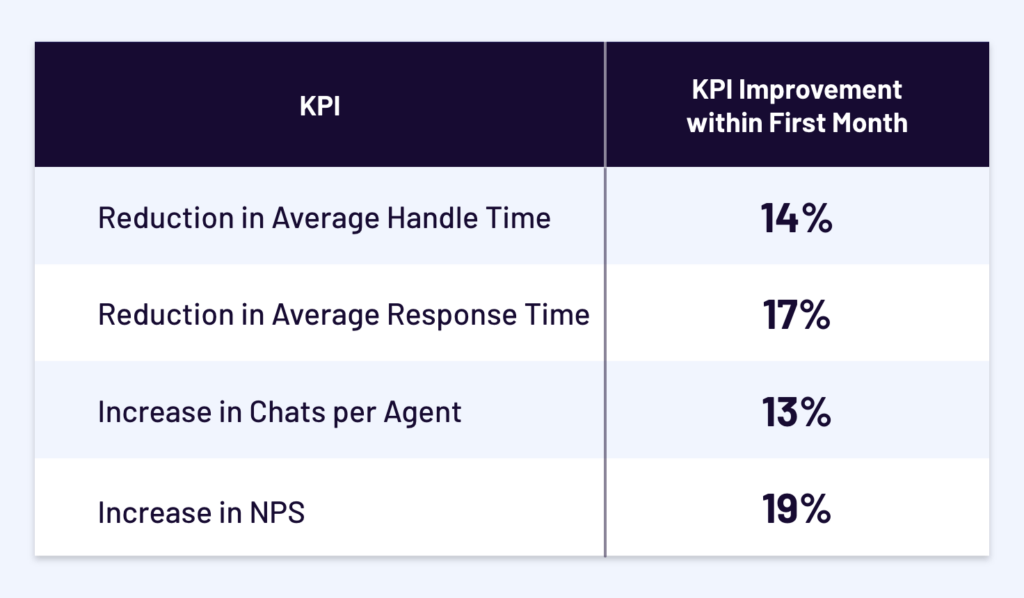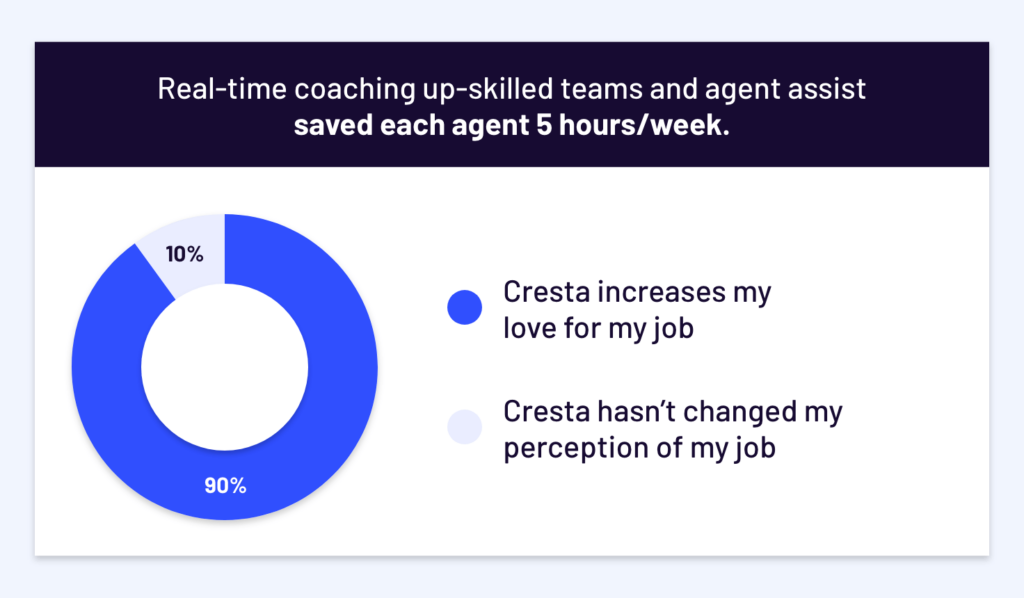
What is conversational AI? Dr. Linda Sapadin, writing for PsychCentral, provides a wonderful breakdown of conversation itself. “Great conversation is constructed with respectful, interesting, enriching content,” she writes. You learn something. You teach something. Your knowledge increases. Your curiosity is piqued. You relish the time spent together.”
This quote captures the essence of what’s being realized, right now, in customer service through conversational AI (i.e., nuance). And the ability for artificial intelligence to play a nuanced role in human conversation is lightyears beyond the robotic error: does not compute clichés of yesteryear. For proof of these advances, one can look at the impact conversational AI is having on modern customer service (CX) centers.
Conversational AI Defined
Only recently available at scale, conversational AI uses digital and telecommunication technologies to create a programmatic, intelligent way to converse with customers in an engaging and effective way. But to understand how conversational AI works, it’s important to understand how conversation works.
Four main principles that make up human conversation are relevant here: intent, conveyance, information, and cues.
- Intent – When a person speaks, they know what they mean. But this does not guarantee the listener will understand what was meant. Conversational feedback is how we ensure we understand one another.
- Conveyance – Words are just part of the greater system of human communication. Everything from specific word choice and tone to facial expressions and how we move our bodies factor into a conversation.
- Content – Every message conveyed through conversation contains information and feeling. When the speaker’s information and emotion aren’t aligned, or if one of these two elements is missing, the listener can get confused. (Note: This is an ongoing challenge regarding forms of electronic communication.)
- Cues – Conversation involves both verbal and non-verbal cues. And, when confused by the speaker, as mentioned above, non-verbal cues tend to get the most attention. For example, if you complimented this article by saying, “This article was the best thing I’ve ever read,” but you did so by screaming angrily up at the sky, the author would be inclined to put more weight behind the latter, non-verbal cue.
So, to have engaging, productive conversations with real people (especially in customer support), conversational AI solutions must be able to navigate these four aspects of a conversation. As a whole, it does so through the combination of eight distinct components:
- Natural language processing (NLP)
- Intent recognition
- Entity recognition
- Fulfillment
- Voice optimized response
- Dynamic text to speech
- Machine learning
- Contextual awareness
This can all seem to be overly complicated. That is, till we manage our expectations by understanding how much conversationally we take for granted. It’s relatively easy to teach a child what “time flies like an arrow” means. But it’s anything but easy when teaching a machine that “pudding soars like a furnace” doesn’t mean the exact same thing.
Conversational AI Helps Teams Talk and Listen to Customers Post-Covid
Even though CX technologies are advancing exponentially, exceeding post-COVID customer expectations still proves to be a challenge. And today’s service excellence is made or broken by how well agents can read their customers and react with empathy while remaining productive and efficient. Despite showing promise in other industries, it took specific advances in natural language processing to bring AI into these conversations, assisting the agent’s ability to both talk and listen.
During times of crisis (e.g., COVID), contact center agents need to focus on making connections with customers, focusing on customers’ cares and concerns. With conversational AI comes decision support to help agents excel in doing so.
While agents speak with customers, natural language processing and natural language understanding (NLU) allow for real-time monitoring of the content of the conversation and the intent of the customer. With this understanding, conversational AI software can support agents in their decision-making while recommending the next best steps for the customer.
NLP and NLU can also be leveraged to assist with information recall during conversations. Doing so helps ensure decision-making and offering the next best steps grows more useful to agents over time. And it also allows conversational AI to recognize prime opportunities for up or cross-selling and provide the agent with content to help them convert.
Conversational AI can even “stack the deck” for agent-customer interactions. Text to speech, machine learning, and contextual awareness allows the software to pre-screen and route customer calls. Before the customer has the chance to say “hello,” conversational AI can already have critical information up in front of the agent, setting their conversation up for success.
In 2019, the benefits to contact centers and CX agents were already potent. As reported by Deloitte, conversational AI:
- Improved customer acquisition, making it easier for customers to find needed information to make purchases 24/7/365.
- Enabled contact center scaling by allowing firms to rapidly scale up and down in a cost-effective manner with no impact on service.
- Enhanced personalization initiatives, as recommended products were more likely to meet the needs of the customer.
- Reduced churn and increased overall customer satisfaction while offering valuable insights into customer feelings and behavior.
- Increased revenue per customer and overall customer satisfaction by using virtual agents to automate basic, routine tasks. The time, liberated by conversational AI, went back to agents, allowing them to focus more on the customer and engage in high-value, meaningful work.
- Reduced cost to serve by:
- Creating cost reduction opportunities from 15-70%, depending on customer interactions deflected into conversational AI-enabled channels.
- Powering algorithms organically trained as customers to use the firm’s own virtual agents, enabling cost-efficient continuous improvement.
Conversational AI Can Coach Human Agents
As powerful as artificial intelligence and conversational AI looks to get, there’s already ample evidence the future involves working alongside machines—instead of machines replacing us. As noted above, Deloitte found that conversational AI could be instrumental in training sales and service agents.
Expert conversational AI is designed to improve the performance of entire contact center teams, leveraging the skills and talents of a firm’s top performers. In Cresta’s case, this is accomplished through a unique combination of outcome-based intelligence, personalized, real-time coaching, and omnichannel intelligence.
As an example, one of the top five current SaaS providers approached us with a challenge. They’d recently identified an obstacle: the need to create a more efficient customer sales solution for their customers and their business. And doing so meant transitioning to online chat and arming their customer sales team to handle more customer conversations.
Our platform helped their team quickly transition to chat messaging and effectively handle the influx of chat volume that comes with the transition from phone to chat. Within the first month, this drove a 13.9% reduction in average handle time (AHT), a 19.1% improvement in Net Promoter Score (NPS), and a 13% increase in conversation capacity.
Arguably even better is these same changes led to an overwhelming increase in how their CX agents felt about their jobs:
Practice What You Preach (A Note for Managers)
It’s easy to mistake what AI can help us do as a silver bullet for leaders and managers. The robots can talk to our customers. The robots can talk to our employees. So, time to slip out the back and enjoy 18 holes at Golfo Relaxo, right? Wrong. Again, unlocking the full potential of products like Cresta involves working with AI (and not on your backswing).
For managers, this means culling the insights, analytics, and trends machines can identify in real-time and using your own expertise to, yes, engage in conversation with your contact center agents to foster lasting growth.
What’s more, for specifics on what conversational AI can do for SaaS companies, learn why it’s important to embrace the marathon, not the sprint.

